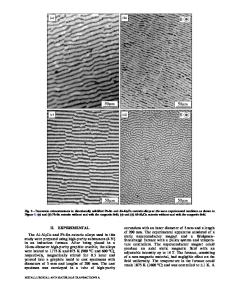Banded solidification microstructures
- PDF / 2,112,265 Bytes
- 10 Pages / 594 x 774 pts Page_size
- 45 Downloads / 280 Views
I.
INTRODUCTION
MOST solidification microstructures such as dendrites or eutectics grow with main features that are perpendicular to the solid-liquid interface. In contrast to this, banded microstructures are quasiperiodic (oscillating) structures which form parallel to the moving interface. Generally, they are formed of two different bands which alternate in time. Depending on the mechanism of their formation, the two alternating bands may consist of (1) different scales of the same microstructure, (2) periodically varying composition, (3) different microstructures of the same phase, (4) different phases, or (5) different phases and microstructures (Figure 1). Banding is a phenomenon which has been observed for many years at relatively low solidification speeds in welded or laser-treated materials.t1-41 Bands have also been observed in directional solidification of peritectic alloys such as in Sn-Cd, tSl Sn-Sb and Zn-Cu, t61Pb-Bi, t7,8,91Ag-Zn,tj~ TiAI,I~~ and Ni-A1J ~~IFinally, in rapid solidification processing, banded microstructures have been detected in many cases, such as in splat quenching,V2.w41 melt spinning,t~5.~rI electron beamy 71 and laser resolidificationl~8-22I of the following alloys: Ag-Cu, I16-191 A1-Cu,I12,15-2~ AI-Fe,[22,2sl AIPd, ~31 and A1-ZrY41 Only recently, more quantitative theories have appeared to explain the growth of various kinds of banding structures. The low velocity peritectic bands were treated for the first time by Trivedi.1261 Models for the high velocity solute trapping bands were initially developed by Coriell and Sekerkat271 and Caroli et al. t281 Davis and co-workers c29-321 carried out detailed linear and weakly nonlinear stability analyses of a plane front, taking into account nonequilibrium phenomena at the solid-liquid interface. Carrard et a/. I33] proposed a phenomenological model where the solid-liquid interface becomes unstable to oscillations when the growth temperature of the plane front rises due to nonequilibrium effects. Karma and Sarkissian W. KURZ, Professor, is with the Department of Materials, Swiss Federal Institute of Technology Lausanne, CH-1015 Lausanne, Switzerland. R. TRIVED1 is Senior Scientist, Ames Laboratory, United States Department of Energy and Professor, Department of Materials Science and Engineering, Iowa State University, Ames, 1A 50011. This article is based on a presentation made at the "Analysis and Modeling of Solidification" symposium as part of the 1994 fall meeting of TMS in Rosemont, Illinois, October 2-6, t994, under the auspices of the TMS Solidification Committee. METALLURGICAL AND MATERIALS TRANSACTIONS A
studied the plane front behavior numerically, which allowed them to give a very detailed description of the interface oscillations including nonplanar morphologies.t34,3sJ Informative overviews of the development of these theories have been given by Huntley and Davis [32] and Karma and Sarkissian.p4J In this article, we will differentiate between externally driven and intemally driven bands. Under externally driven bands, it
Data Loading...











